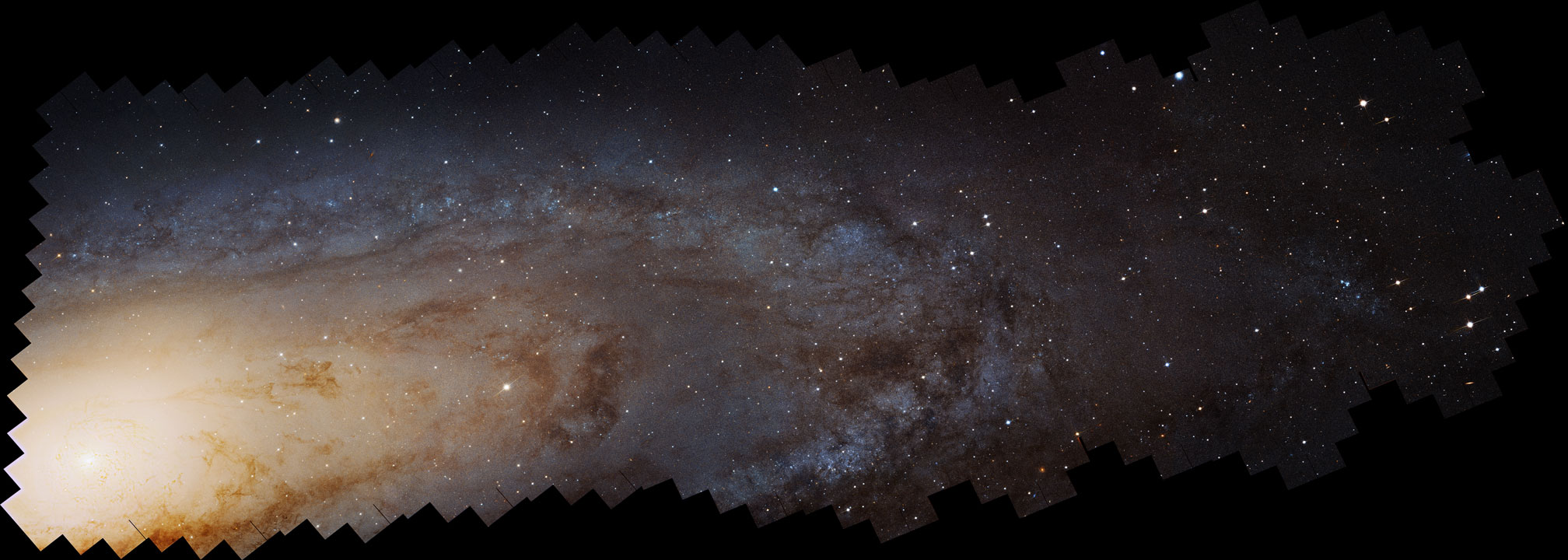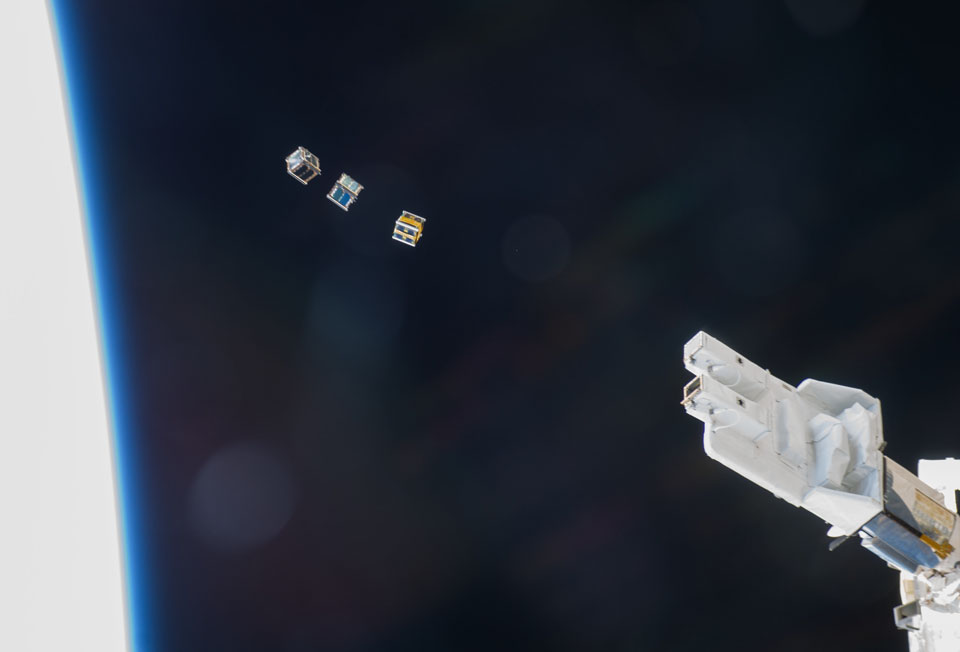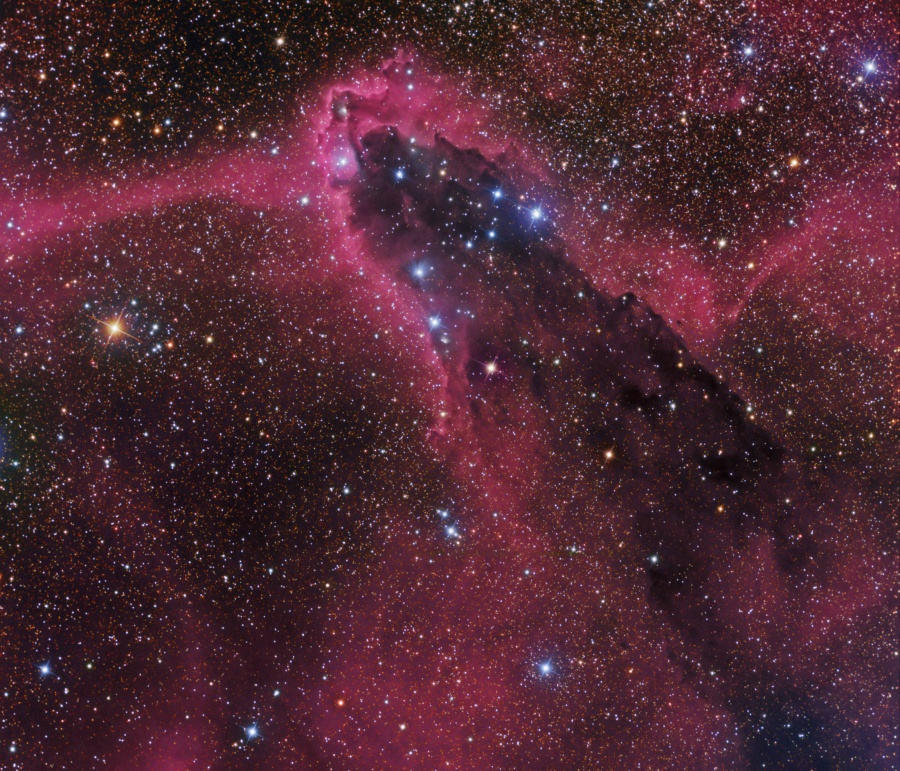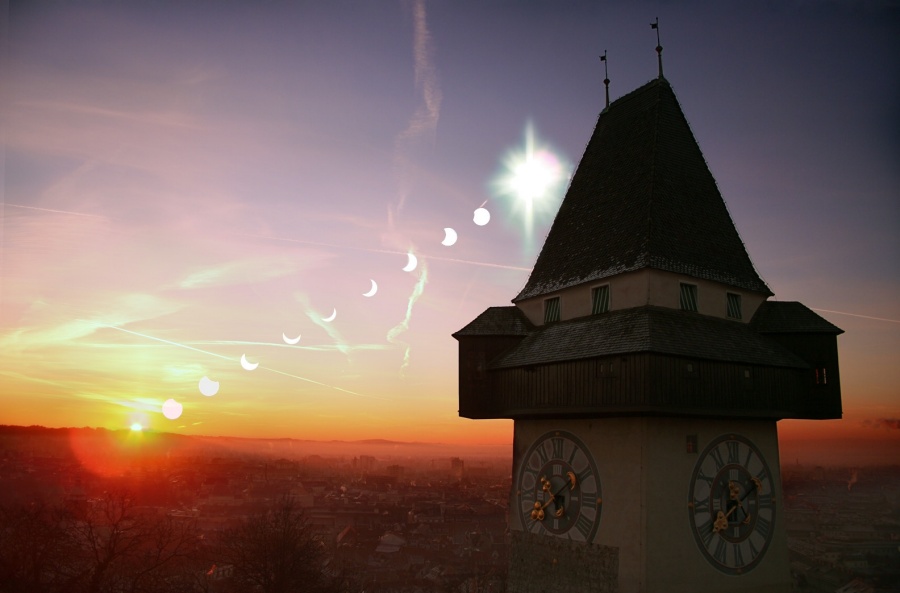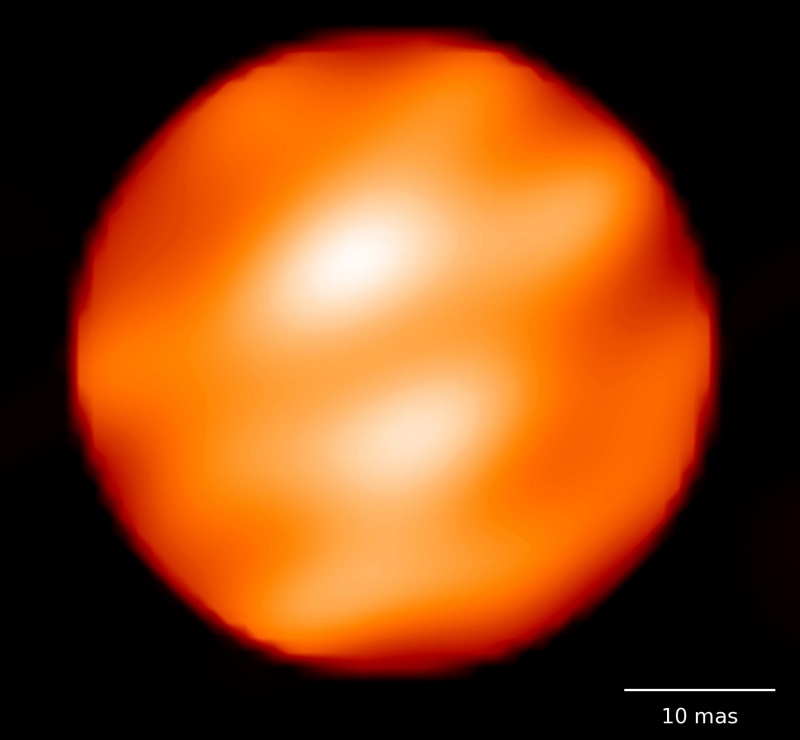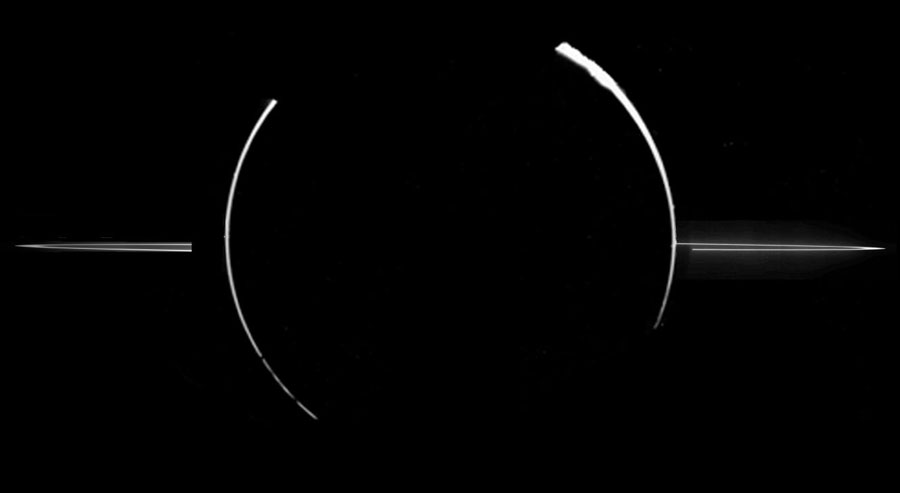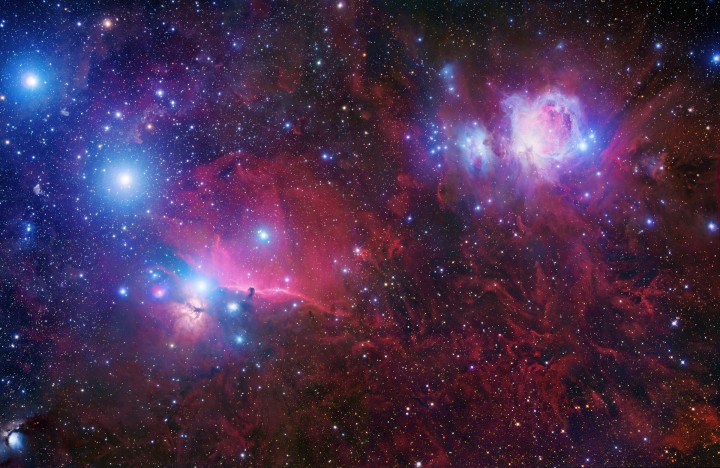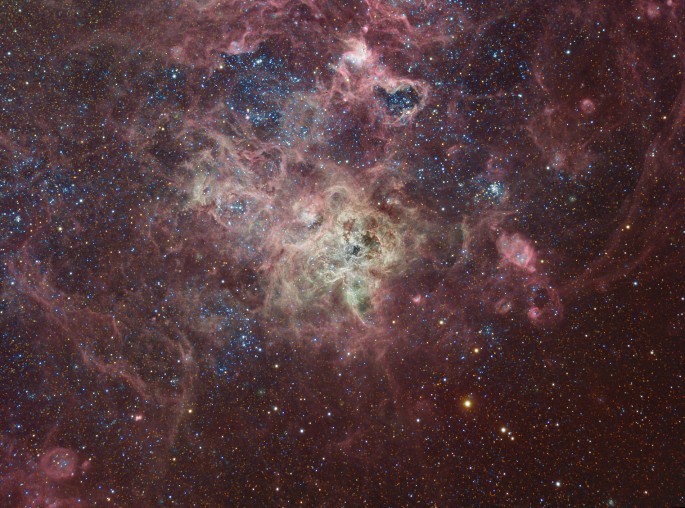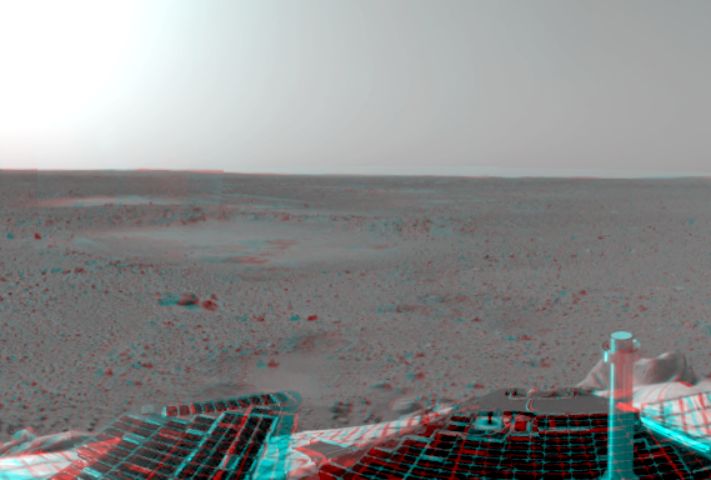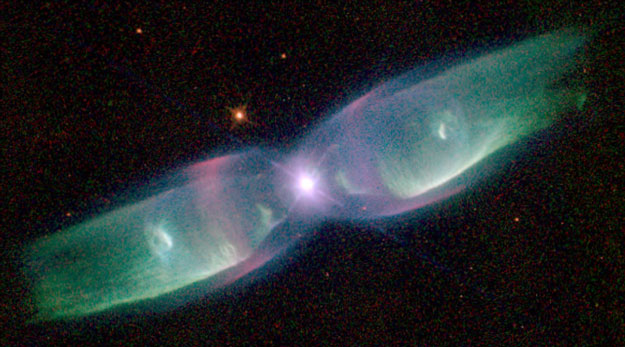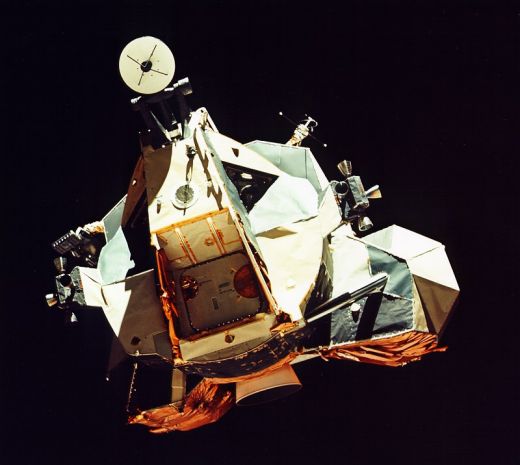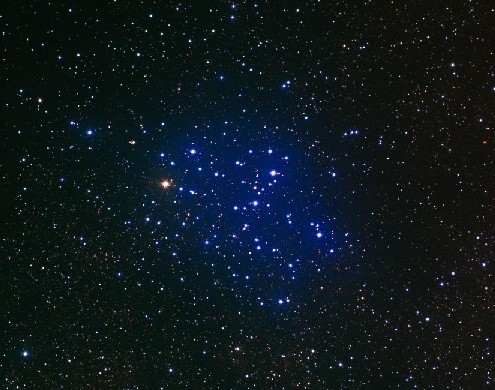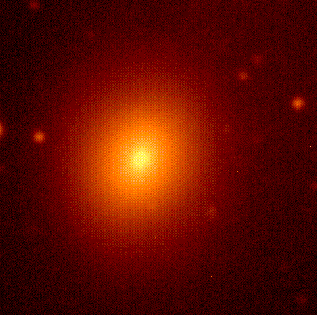| << Previous | Index | Next >> |
2015
2014 Cubes are orbiting the Earth. Measuring ten-centimeters on a side, CubeSats -- each roughly the size of a large coffee mug -- are designed to be inexpensive both to build and to launch. Pictured above, three CubeSats were released from the International Space Station (ISS) last November by the arm of the Japanese Kibo Laboratory module. CubeSats are frequently created by students as part of university science or engineering projects and include missions such as collecting wide angle imagery of the Earth, testing orbital radio communications, monitoring the Earth's magnetic field, and exploring the Earth's surrounding radiations. Depending on the exact height of their release, CubeSats will re-enter the Earth's atmosphere on the time scale of months to years.
2013 In silhouette against a crowded star field toward the constellation Scorpius, this dusty cosmic cloud evokes for some the image of an ominous dark tower. In fact, clumps of dust and molecular gas collapsing to form stars may well lurk within the dark nebula, a structure that spans almost 40 light-years across this gorgeous telescopic portrait. Known as a cometary globule, the swept-back cloud, extending from the lower right to the head (top of the tower) left and above center, is shaped by intense ultraviolet radiation from the OB association of very hot stars in NGC 6231, off the upper edge of the scene. That energetic ultraviolet light also powers the globule's bordering reddish glow of hydrogen gas. Hot stars embedded in the dust can be seen as bluish reflection nebulae. This dark tower, NGC 6231, and associated nebulae are about 5,000 light-years away.
2012 From Sagittarius to Scorpius, the central Milky Way is a truly beautiful part of planet Earth's night sky. The gorgeous region is captured in this wide field image spanning about 30 degrees. The impressive cosmic vista, taken in 2010, shows off intricate dust lanes, bright nebulae, and star clusters scattered through our galaxy's rich central starfields. Starting on the left, look for the Lagoon and Trifid nebulae, the Cat's Paw, while on the right lies the Pipe dark nebula, and the colorful clouds of Rho Ophiuchi and Antares (right). The actual center of our Galaxy lies about 26,000 light years away and can be found here.
2011 For many Europeans, the Sun and New Moon rose together on January 4 in a partial solar eclipse. Arriving close on the heels of the new year, it was the first of a series of four(!) partial solar eclipses due in 2011. This composite image documents the graceful celestial event in colorful morning skies over Graz, Austria. Beginning before sunrise, frames were taken to record the position and progress of the eclipse every 15 minutes. As Sun and Moon rose above the eastern horizon, the town of Graz is seen bathed in warming sunlight only partially blocked by the New Moon, spreading beneath the town's landmark clock tower.
2010 Betelgeuse really is a big star. If placed at the center of our Solar System it would extend to the orbit of Jupiter. But like all stars except the Sun, Betelgeuse is so distant it usually appears as a single point of light, even in large telescopes. Still, astronomers using interferometry at infrared wavelengths can resolve the surface of Betelgeuse and reconstructed this image of the red supergiant. The intriguing picture shows two, large, bright, star spots. The spots potentially represent enormous convective cells rising from below the supergiant's surface. They are bright because they're hotter than the rest of the surface, but both spots and surface are cooler than the Sun. Also known as Alpha Orionis, Betelgeuse is about 600 light-years away.
2009 How hazy is Jupiter's upper atmosphere? To help find out, astronomers deployed the Hubble Space Telescope to watch Jupiter eclipse its moon Ganymede. Although Ganymede circles Jupiter once a week, a particularly useful occultation occurs more rarely. Such an occultation was captured in great visual detail in April 2007. When near Jupiter's limb, Ganymede reflects sunlight though Jupiter's upper atmosphere, allowing astronomers to search for haze by noting a slight dimming at different colors. One result of this investigation was the above spectacular image, where bands of clouds that circle Jupiter are clearly visible, as well as magnificent swirling storm systems such as the Great Red Spot. Ganymede, at the image bottom, also shows noticeable detail on its dark icy surface. Since Jupiter and Ganymede are so bright, many eclipses can be seen right here on Earth with a small telescope.
2008 Why does Jupiter have rings? Jupiter's rings were discovered in 1979 by the passing Voyager 1 spacecraft, but their origin was a mystery. Data from the Galileo spacecraft that orbited Jupiter from 1995 to 2003 later confirmed that these rings were created by meteoroid impacts on small nearby moons. As a small meteoroid strikes tiny Adrastea, for example, it will bore into the moon, vaporize, and explode dirt and dust off into a Jovian orbit. Pictured above is an eclipse of the Sun by Jupiter, as viewed from Galileo. Small dust particles high in Jupiter's atmosphere, as well as the dust particles that compose the rings, can be seen by reflected sunlight.
2007 Adrift 1,500 light-years away in one of the night sky's most recognizable constellations, the glowing Orion Nebula and the dark Horsehead Nebula are contrasting cosmic vistas. But even fainter filaments of glowing gas are easily traced throughout the region in this stunning composite image that includes exposures filtered to record emission from hydrogen atoms. The view reveals extensive nebulosities associated with the giant Orion Molecular Cloud complex, itself hundreds of light-years across. A magnificent emission region, the Orion Nebula (aka M42) lies at the upper right of the picture. Immediately to its left are a cluster of prominent bluish reflection nebulae sometimes called the Running Man. The Horsehead nebula appears as a dark cloud, a small silhouette notched against the long red glow left of center. Alnitak is the easternmost star in Orion's belt and the brightest star to the left of the Horsehead. Below Alnitak is the Flame Nebula, with clouds of bright emission and dramatic dark dust lanes. Completing the trio of Orion's belt stars, bluish Alnilam and Mintaka form a line with Alnitak, extending to the upper left.
2006 First cataloged as a star, 30 Doradus is actually an immense star forming region in nearby galaxy The Large Magellanic Cloud. The region's spidery appearance is responsible for its popular name, the Tarantula Nebula, except that this tarantula is about 1,000 light-years across, and 180,000 light-years away in the southern constellation Dorado. If the Tarantual Nebula were at the distance of the Orion Nebula (1,500 light-years), the nearest stellar nursery to Earth, it would appear to cover about 30 degrees on the sky or 60 full moons. The spindly arms of the Tarantula Nebula surround NGC 2070, a cluster that contains some of the intrinsically brightest, most massive stars known. Intriguing details of the nebula's core can be seen in this remarkable skyscape, a composite of 31 hours of exposure time. This cosmic Tarantula also lies near the site of the closest recent supernova.
2005 At the edge of a dense molecular cloud, filaments of gas, cosmic dust, and a multitude of young stars beckon in this penetrating image of the Orion Nebula. Alluring structures in the well-known star forming region are revealed here in infrared light as viewed by a new Hawaiian eye - WFCAM - a powerful wide field camera commissioned at the United Kingdom Infrared Telescope (UKIRT) on Mauna Kea. Only a fraction of WFCAM's full field, this picture covers about 11 light-years at the 1,500 light-year distance of the nebula. In the image, otherwise invisible infrared light has been mapped into visible colors. Red represents narrow-band infrared emission from hydrogen molecules at a wavelength of 2.12 microns, green is emission at 2.2 microns, and blue is emission at 1.25 microns. Visible light has a wavelength of about 0.5 microns (micrometers).
2004 Working late, tired mission members nicknamed the smooth-looking depression to the left of center in this image from the martian surface, Sleepy Hollow. The picture is a portion of the 3D panorama of the Spirit rover's landing site released yesterday, constructed with data from the Mars rover's navigation cameras. Use red/blue glasses, red for the left eye, to get the 3D effect. Sleepy Hollow is estimated to be around 9 meters (30 feet) in diameter and about 12 meters (40 feet) away. Possibly an impact crater, the martian surface feature is a tantalizing potential site for a future visit when the golf cart-sized robotic rover ventures forth. Covered with solar arrays, the rear deck of the rover is also visible in this view along with the top of an antenna at the right. An innovative camera calibration target, a martian sundial, can be seen left of the antenna, mounted near the edge of the rover's deck.
2003 Sometimes, during a total eclipse of the Sun, a strange shadow of darkness can be seen stretching off into the distance. Called a shadow cone, they are visible because the Earth's atmosphere is not completely transparent, scattering sunlight and hence appearing blue during the day. Shadow cones are particularly dramatic for eclipses near the horizon, as geometry creates a long corridor of sun-blocked air. Visible above is a shadow cone caught during a total solar eclipse visible last month from South Australia. The eclipsed Sun itself still appears bright because of light from the surrounding corona. The digital camera on the left is zoomed in to show a better image of the actual eclipse.
2002 Are stars better appreciated for their art after they die? Actually, stars usually create their most artistic displays as they die. In the case of low-mass stars like our Sun and M2-9 pictured above, the stars transform themselves from normal stars to white dwarfs by casting off their outer gaseous envelopes. The expended gas frequently forms an impressive display called a planetary nebula that fades gradually over thousand of years. M2-9, a butterfly planetary nebula 2100 light-years away shown in representative colors, has wings that tell a strange but incomplete tale. In the center, two stars orbit inside a gaseous disk 10 times the orbit of Pluto. The expelled envelope of the dying star breaks out from the disk creating the bipolar appearance. Much remains unknown about the physical processes that cause planetary nebulae.
2001 Awkward and angular looking, Apollo 17's lunar module Challenger was designed for flight in the vacuum of space. This sharp picture from the command module America, shows Challenger's ascent stage in lunar orbit. Small reaction control thrusters are at the sides of the moonship with the bell of the ascent rocket engine itself underneath. The hatch allowing access to the lunar surface is visible in the front and a round radar antenna appears at the top. This spaceship performed gracefully, landing on the moon and returning the Apollo astronauts to the orbiting command module in December of 1972 - but where is Challenger now? Its descent stage remains at the Apollo 17 landing site, Taurus-Littrow. The ascent stage was intentionally crashed nearby after being jettisoned from the command module prior to the astronauts' return to planet Earth. Apollo 17's mission was the sixth and last time astronauts have landed on the moon.
2000 Many will long remember where they were and what they were doing when the calendar rolled over to the year 2000. On Mars, of course, that date was nothing special and the Mars Global Surveyor spacecraft continued with business as usual - systematically recording images of the Red Planet from orbit. In fact, this striking high-resolution picture was taken less than 7 hours after the new year began for planet Earth's "Universal Time" zone. The area seen is about 3 kilometers across at a maximum resolution of 4.5 meters per pixel. It shows a wonderful variety of surface features and textures in the Martian northern hemisphere region Nilosyrtis Mensae.
1999 To some, the outline of the open cluster of stars M6 resembles a butterfly. M6, also known as NGC 6405, spans about 20 light-years and lies about 2,000 light years distant. M6 can best be seen in a dark sky with binoculars towards the constellation of Scorpius, coving about as much of the sky as the full moon. Like other open clusters, M6 is composed predominantly of young blue stars, although the brightest star is nearly orange. M6 is estimated to be about 100 million years old. Determining the distance to clusters like M6 helps astronomers calibrate the distance scale of the universe.
1998 Oh what a tangled web a planetary nebula can weave. The Red Spider Planetary Nebula shows the complex structure that can result when a normal star ejects its outer gases and becomes a white dwarf star. Officially tagged NGC 6537, this two-lobed symmetric nebula houses one of the hottest white dwarfs ever observed, probably as part of binary star system. Internal winds emanating from the central stars, shown in the central inset, have been measured in excess of 300 kilometers per second. These hot winds expand the nebula, flow along the nebula's walls, and cause gas and dust to collide. Atoms caught in these colliding shocks radiate light shown in the above representative-light picture.
1997 The Sun is a bubbling ball of extremely hot gas. In this false-color picture, light blue regions are extremely hot - over 1 million degrees, while dark blue regions are slightly cooler. The camera filter used was highly sensitive to the emission of highly charged iron ions, which trace the magnetic field of the Sun. The rich structure of the image shows the great complexity of the Sun's inner corona. A small active region can be seen just to the right and above center. This picture was taken in ultraviolet (extremely blue) light by the Extreme-ultraviolet Imaging Telescope (EIT) on board the Solar and Heliospheric Observatory (SOHO) spacecraft, which is orbiting the Sun just ahead of the Earth, at the L1 point. SOHO was launched in 1995 and will continually monitor the Sun for several years.
1996 Being the largest galaxy around can sometimes make you popular. Pictured is M31's companion galaxy M32. M31, the Andromeda galaxy, is the largest galaxy in our Local Group of galaxies - even our tremendous Milky Way Galaxy is smaller. Little M32 is visible in most pictures of M31 - it is the small circular spot north of M31's center. M32 is a dwarf elliptical galaxy. Elliptical galaxies have little or no measurable gas or dust - they are composed completely of stars and typically appear more red than spiral galaxies. Elliptical galaxies do not have disks - they generally have oblong shapes and therefore show elliptical profiles on the sky.
| << Previous | Index | Next >> |
